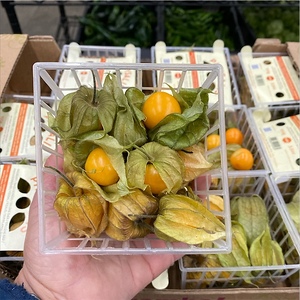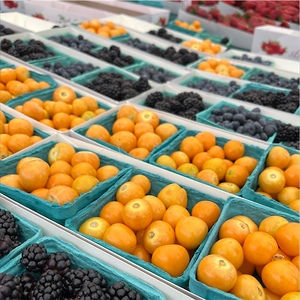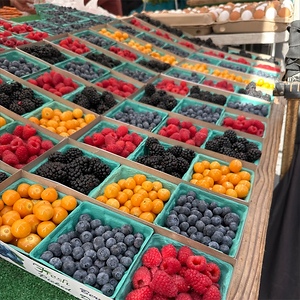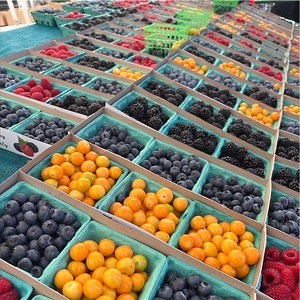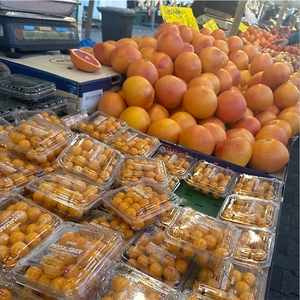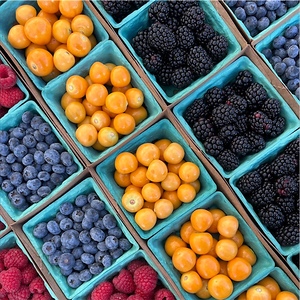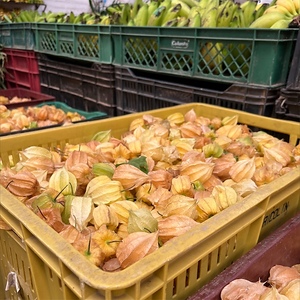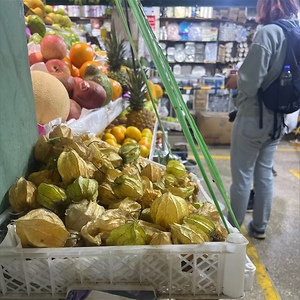


Cape Gooseberries
Estimated Inventory, 12 ct : 6.25
This item was last sold on : 07/29/25
Description/Taste
Cape gooseberries are globular fruits, averaging 1 to 2 centimeters in diameter, and are encased in a green to tan, papery husk that forms an inflated, lantern shape. The skin of the fruit is initially waxy and slightly sticky when removed from the husk, giving way to a smooth and taut consistency. The skin also transitions from green to orange-yellow when ripe. Underneath the surface, the flesh is aqueous, soft, yellow-orange, and filled with many small, crunchy, and edible, cream-colored seeds. Cape gooseberries have a sweet-tart flavor that is reminiscent of a cherry tomato crossed with tangy notes of pineapple, mango, vanilla, strawberry, and Meyer lemon.
Seasons/Availability
Cape gooseberries are available year-round, with a peak season in the late summer through fall.
Current Facts
Cape gooseberries, botanically classified as Physalis peruviana, are sweet and tangy fruits belonging to the Solanaceae or nightshade family. Known by many names, including Goldenberry, Husk Cherry, Peruvian Ground Cherry, and Poha berry, Cape gooseberries are native to South America and have spread around the world, naturalizing in many regions. Cape gooseberries are of no relation to the common gooseberry and are actually a close relative of the tomato and other members of the nightshade family. The tart fruits are viewed from many different perspectives depending on the region they are grown in and can range from being a common, unimportant weed to being seen as a valuable, exported crop. Despite their varying reputation, Cape gooseberries are utilized in an array of sweet and savory culinary preparations and are considered a niche crop, often grown fresh for local markets or produced for use in processed exports.
Nutritional Value
Cape gooseberries are an excellent source of vitamins A and C, antioxidants that boost the immune system, increase collagen production, and reduce inflammation. The fruits also contain phosphorus and calcium to build strong bones and teeth, potassium to balance fluid levels within the body, iron, riboflavin, and have been used in natural medicines for their anti-inflammatory properties.
Applications
Cape gooseberries are suited for raw and cooked preparations and shine when boiled or baked. The husks should be discarded before consumption as they have a bitter taste and are inedible, but they can be used as an ornamental decoration on baked goods and desserts. Cape gooseberries can be eaten fresh, out-of-hand as a sweet-tart snack, sliced and tossed into green and fruit salads, chopped into salsas, blended into smoothies, or made into a puree. The small fruits are also easily incorporated into cereals, oatmeal, and yogurt and can be sliced and served as a topping over ice cream. In England, Cape gooseberries are popularly dipped in chocolate, fondant, icing, or pricked and rolled in sugar as a bite-sized dessert. The fruit’s high pectin content also allows the berries to be cooked into preserves, compotes, and syrups for use in pies, crumbles, and tarts. In addition to sweet applications, Cape gooseberries are used similarly to tomatoes and can be cooked into gazpacho, mixed into rice and stuffing, baked into bread and muffins, or halved and served with burrata cheese, basil, and a drizzle of balsamic vinegar. The berries can also be canned or dried for extended use. Cape gooseberries pair well with honey, spices such as cinnamon, cardamom, and pumpkin, red grapes, apricots, blueberries, strawberries, ginger, and nuts such as hazelnuts, walnuts, and pecans. The fresh fruits will keep for 1 to 2 weeks when stored in a cool and dark place.
Ethnic/Cultural Info
Cape gooseberries earned their name from their commercial success in the Cape of Good Hope in South Africa. First introduced in 1807, the fruits became a prevalent ingredient in jams and were highly exported in canned form. At the peak of their popularity, Cape gooseberries were introduced to Australia from the Cape of Good Hope, and local Australians gave the fruit its “Cape” moniker in reference to where the fruits originally came from. The name stuck and is one of the most prominent names used worldwide for the fruits in the modern day.
Geography/History
Cape gooseberries are native to Brazil and were naturalized within the Chilean and Peruvian highland regions of the Andes Mountains during ancient times. The Incas were closely associated with the cultivation of the fruit, and in 1774, the plant was introduced to England by explorers returning from the New World. Cape gooseberries then spread to South Africa in 1807 and were also introduced to many other tropical and temperate regions worldwide in the 20th century. Today Cape gooseberries can be found at specialty and local markets in Europe, Africa, Asia, especially in China and India, the Philippines, Malaysia, Australia, New Zealand, the Caribbean, South America, and Hawaii and Florida in the United States.
Featured Restaurants
Restaurants currently purchasing this product as an ingredient for their menu.
| The Wild Thyme Company | San Diego CA | 858-527-0226 |
| Artifact at Mingei | San Diego CA | 619-846-2164 |
| C 2 C | San Diego CA | 619-972-9345 |
| Le Coq | La Jolla CA | 858-427-1500 |
| Shoreside Support Boat | San Diego CA | 704-277-7929 |
| Ron Oliver | San Diego | 619-295-3172 |
| Venissimo Cheese Hillcrest | San Diego CA | 619-491-0708 |
| Lilo NA | Carlsbad CA | 619-385-0914 |
| Jeune Et Jolie | Carlsbad CA | 858-231-0862 |
| Boujiemana | San Diego CA | 415-710-0510 |
| Kinme Omakase | San Diego CA | 619-231-0700 |
| All Aboard Charcuterie & Provisions | San Diego CA | 619-994-5267 |
| Make Stuff Good | San Diego CA | 949-547-9470 |
| Rancho Valencia | Del Mar CA | 858-756-1123 |
| The Tavern | Coronado CA | 602-628-5890 |
| Kettner Exchange | San Diego CA | 909-915-9877 |
| Viewpoint Brewing Co. | Del Mar CA | 858-205-9835 |
| Shootz Fish X Beer (Carlsbad) | Carlsbad CA | 760-450-8070 |
| Jeune Et Jolie (SOMM) | Carlsbad CA | 858-231-0862 |
| Black Radish | San Diego CA | 619-775-7412 |
| Dija Mara | Oceanside CA | 760-231-5376 |
| Addison Del Mar | Del Mar CA | 858-350-7600 |
| Manna | Encinitas CA | 510-366-3057 |
| The Victorian at Hill Street | Oceanside CA | 442-266-8285 |
| Pendry SD (Pastry) | San Diego CA | 619-738-7000 |
| Lauberge Del Mar | Del Mar CA | 858-259-1515 |
| Cal A Vie | Vista CA | 760-945-2055 |
| Reata Glen | Ladera Ranch CA | 949-545-2250 |
| Nomad Donuts | San Diego CA | 619-431-5000 |
| Coco Maya by Miss Bs | San Diego CA | 858-245-3780 |
| Park Hyatt Aviara (Ember & Rye) | Carlsbad CA | 760-448-1234 |
| The Kitchen at MCASD | La Jolla CA | 619-880-8719 |
Recipe Ideas
Recipes that include Cape Gooseberries. One
| Healthy Green Kitchen |
|
Anise Hyssop and Honey Poached Peaches and Cape Gooseberries |
| Ang Sarap |
|
Cape Gooseberries and Strawberry Flaugnarde |



